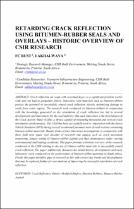 ResearchSpace
ResearchSpace
Retarding crack reflection using bitumen-rubber seals and overlays – historic overview of CSIR Research
JavaScript is disabled for your browser. Some features of this site may not work without it.
- ResearchSpace
- →
- Research Publications/Outputs
- →
- Conference Publications
- →
- View Item
| dc.contributor.author |
Rust, Frederik C

|
|
| dc.contributor.author |
Akhalwaya, Imraan

|
|
| dc.date.accessioned | 2018-10-23T12:39:59Z | |
| dc.date.available | 2018-10-23T12:39:59Z | |
| dc.date.issued | 2018-09 | |
| dc.identifier.citation | Rust, F.C. and Akhalwaya, I. 2018. Retarding crack reflection using bitumen-rubber seals and overlays – historic overview of CSIR Research. Rubberized Asphalt Rubber 2018 (RAR2018), Kruger National Park, Protea Hotel, South Africa, 25-28 September 2018 | en_US |
| dc.identifier.uri | http://www.consulpav.com/rar2018/#!page-program | |
| dc.identifier.uri | http://hdl.handle.net/10204/10486 | |
| dc.description | Paper presented at Rubberized Asphalt Rubber 2018 (RAR2018), Kruger National Park, Protea Hotel, South Africa, 25-28 September 2018 | en_US |
| dc.description.abstract | Crack reflection on roads with cemented layers is a significant problem world-wide and can lead to premature failure. Innovative road materials such as bitumen-rubbers possess the potential to successfully retard crack reflection, thereby minimizing damage to roads from water ingress. The research work conducted on bitumen-rubbers in conjunction with the knowledge generated on the retardation of crack reflection has led to several developments and innovations for the road industry. One such innovation is the development of the Crack Activity Meter (CAM), a device capable of measuring horizontal and vertical crack movements simultaneously. The CAM has been successfully used in conjunction with the Heavy Vehicle Simulator (HVS) during several accelerated pavement tests of road sections containing bitumen-rubber materials. Results from various laboratory investigations in conjunction with these field tests spans over decades of research into aspects such as crack movement monitoring, fatigue testing of bitumen-rubber asphalt and their performance under varying environmental and loading conditions. This paper provides a historic overview of the research conducted at the CSIR relating to the use of bitumen-rubber materials to successfully retard crack reflection. The paper additionally discusses the initial history, developments and early laboratory work conducted on the performance of bitumen-rubber materials in South Africa. Finally the paper identifies gaps in research in line with current day trends and developments that may be explored further for new methods of improving the successful retardation of crack reflection. | en_US |
| dc.language.iso | en | en_US |
| dc.relation.ispartofseries | Worklist;21562 | |
| dc.subject | Crack Reflection | en_US |
| dc.subject | Bitumen-rubber Asphalt | en_US |
| dc.subject | Bitumen-rubbers | en_US |
| dc.subject | Rubber-modified Binders | en_US |
| dc.title | Retarding crack reflection using bitumen-rubber seals and overlays – historic overview of CSIR Research | en_US |
| dc.type | Conference Presentation | en_US |
| dc.identifier.apacitation | Rust, F. C., & Akhalwaya, I. (2018). Retarding crack reflection using bitumen-rubber seals and overlays – historic overview of CSIR Research. http://hdl.handle.net/10204/10486 | en_ZA |
| dc.identifier.chicagocitation | Rust, Frederik C, and Imraan Akhalwaya. "Retarding crack reflection using bitumen-rubber seals and overlays – historic overview of CSIR Research." (2018): http://hdl.handle.net/10204/10486 | en_ZA |
| dc.identifier.vancouvercitation | Rust FC, Akhalwaya I, Retarding crack reflection using bitumen-rubber seals and overlays – historic overview of CSIR Research; 2018. http://hdl.handle.net/10204/10486 . | en_ZA |
| dc.identifier.ris | TY - Conference Presentation AU - Rust, Frederik C AU - Akhalwaya, Imraan AB - Crack reflection on roads with cemented layers is a significant problem world-wide and can lead to premature failure. Innovative road materials such as bitumen-rubbers possess the potential to successfully retard crack reflection, thereby minimizing damage to roads from water ingress. The research work conducted on bitumen-rubbers in conjunction with the knowledge generated on the retardation of crack reflection has led to several developments and innovations for the road industry. One such innovation is the development of the Crack Activity Meter (CAM), a device capable of measuring horizontal and vertical crack movements simultaneously. The CAM has been successfully used in conjunction with the Heavy Vehicle Simulator (HVS) during several accelerated pavement tests of road sections containing bitumen-rubber materials. Results from various laboratory investigations in conjunction with these field tests spans over decades of research into aspects such as crack movement monitoring, fatigue testing of bitumen-rubber asphalt and their performance under varying environmental and loading conditions. This paper provides a historic overview of the research conducted at the CSIR relating to the use of bitumen-rubber materials to successfully retard crack reflection. The paper additionally discusses the initial history, developments and early laboratory work conducted on the performance of bitumen-rubber materials in South Africa. Finally the paper identifies gaps in research in line with current day trends and developments that may be explored further for new methods of improving the successful retardation of crack reflection. DA - 2018-09 DB - ResearchSpace DP - CSIR KW - Crack Reflection KW - Bitumen-rubber Asphalt KW - Bitumen-rubbers KW - Rubber-modified Binders LK - https://researchspace.csir.co.za PY - 2018 T1 - Retarding crack reflection using bitumen-rubber seals and overlays – historic overview of CSIR Research TI - Retarding crack reflection using bitumen-rubber seals and overlays – historic overview of CSIR Research UR - http://hdl.handle.net/10204/10486 ER - | en_ZA |





